CADILLAC FLEETWOOD 1995 2.G Owners Manual
Manufacturer: CADILLAC, Model Year: 1995, Model line: FLEETWOOD, Model: CADILLAC FLEETWOOD 1995 2.GPages: 306, PDF Size: 15.72 MB
Page 171 of 306
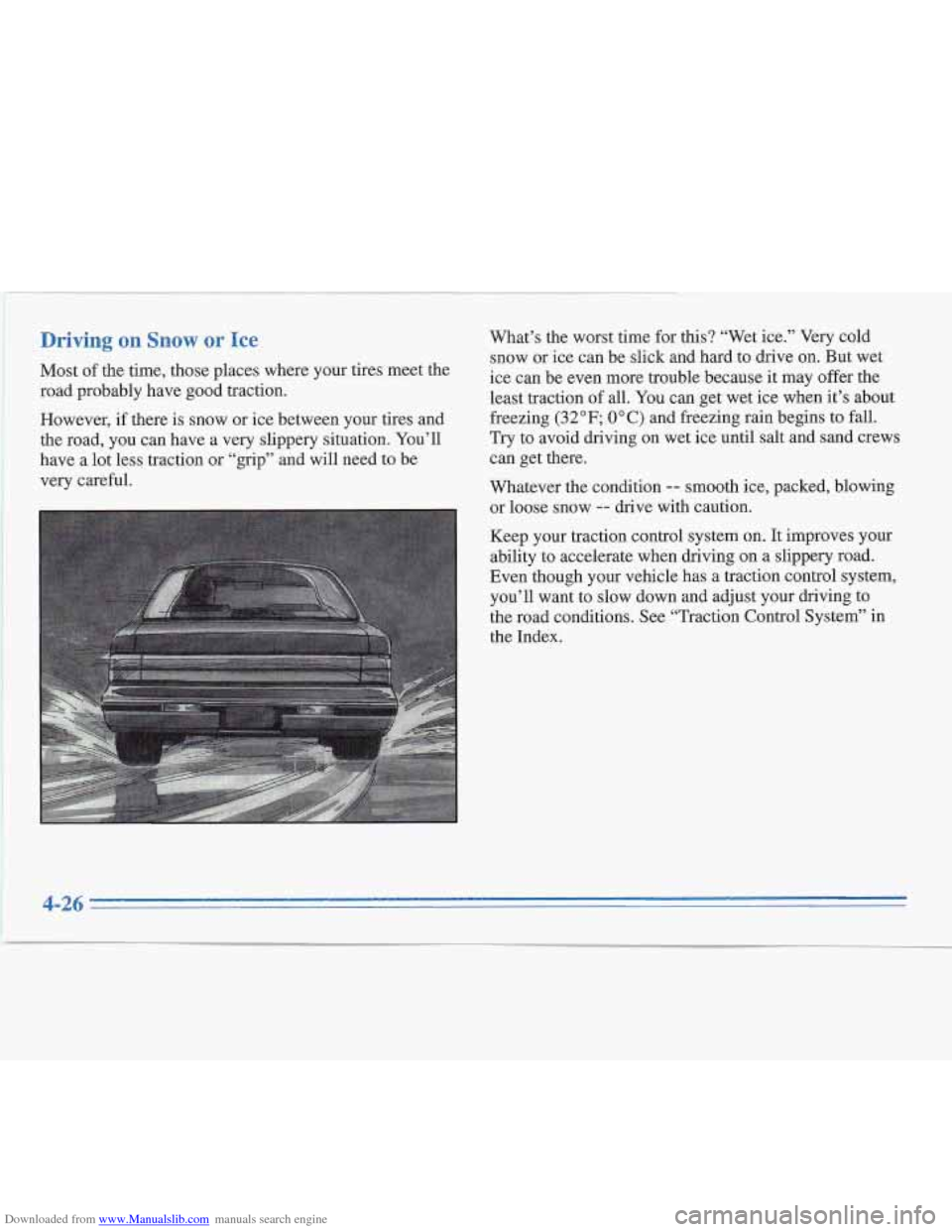
Downloaded from www.Manualslib.com manuals search engine Driving on Snow or Ice
Most of the time, those places where your tires meet the
road probably have
good traction.
However,
if there is snow or ice between your tires and
the road, you can have a very slippery situation. You’ll
have a lot less traction
or “grip” and will need to be
very careful.
4-26
Page 172 of 306
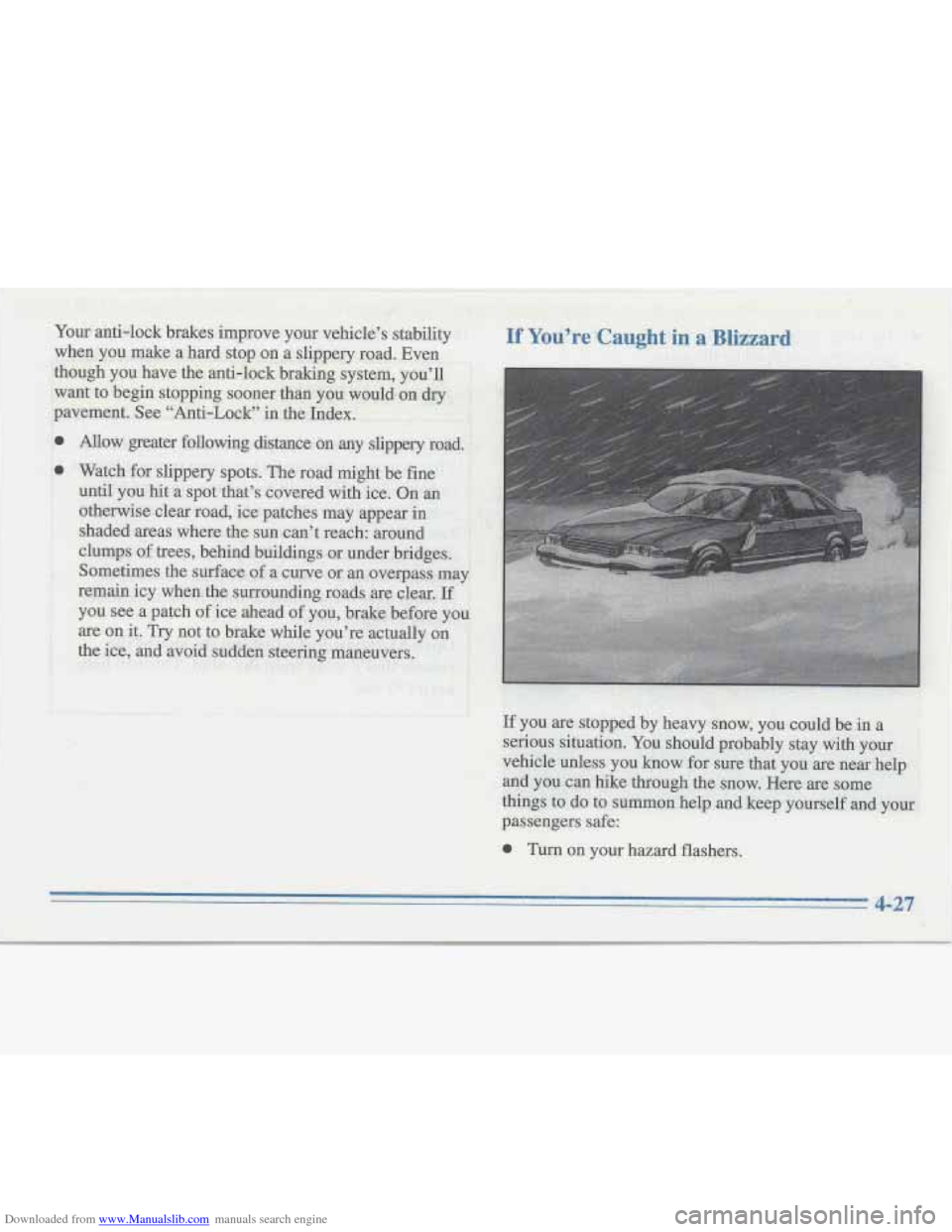
Downloaded from www.Manualslib.com manuals search engine
Page 173 of 306
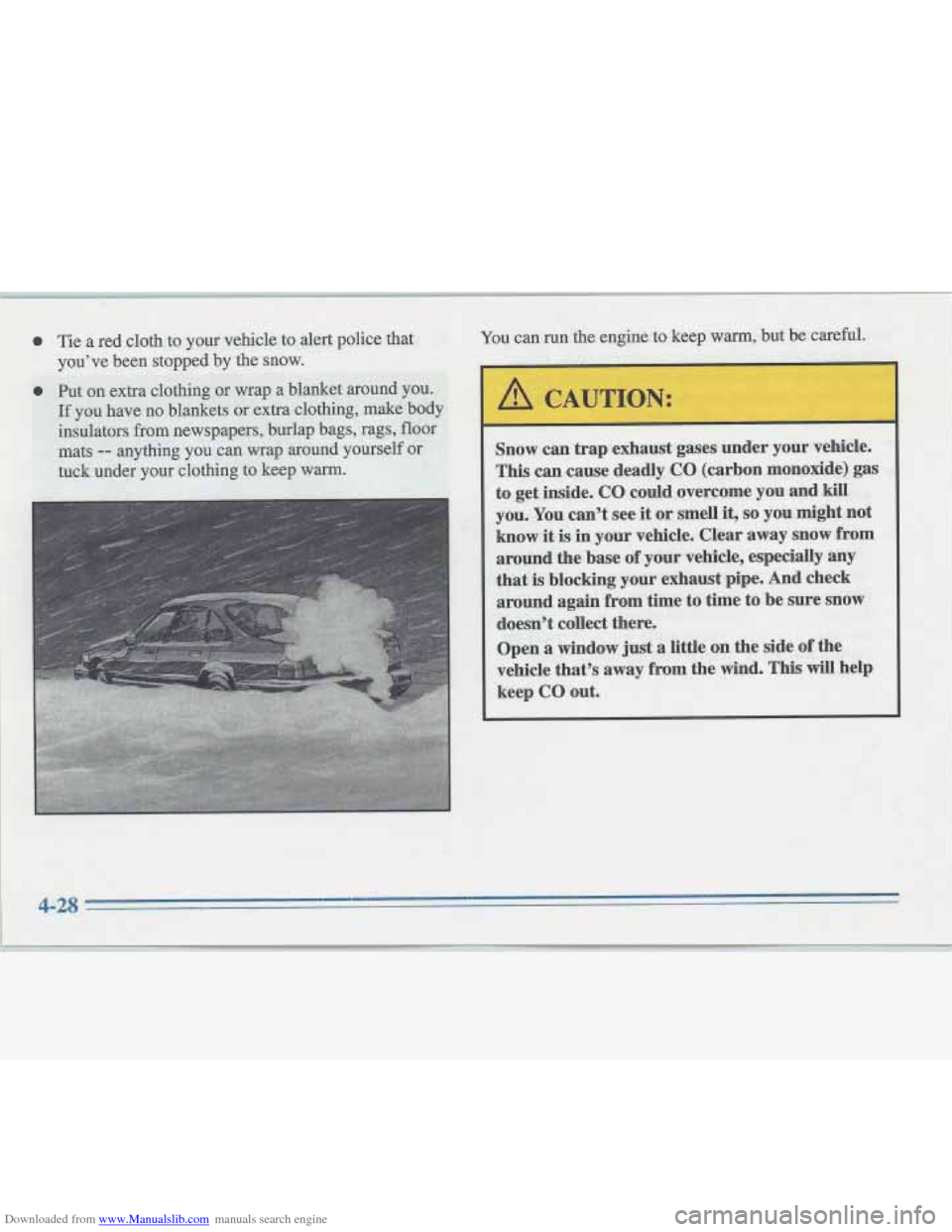
Downloaded from www.Manualslib.com manuals search engine
Page 174 of 306
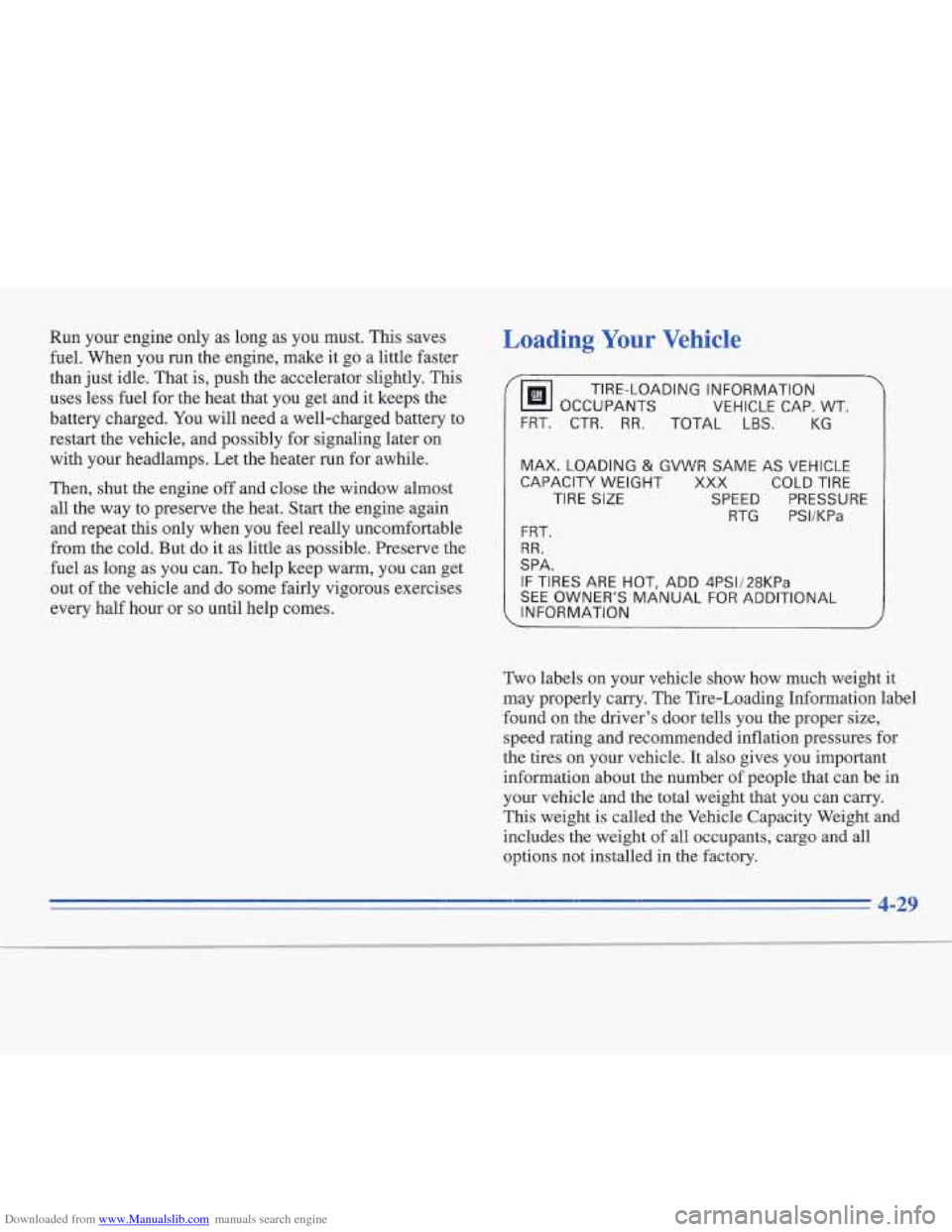
Downloaded from www.Manualslib.com manuals search engine Run your engine only as long as you must. This saves
fuel. When you run the engine, make it go a little faster
than just idle. That is, push the accelerator slightly. This
uses
less fuel for the heat that you get and it keeps the
battery charged. You will need a well-charged battery to
restart the vehicle, and possibly for signaling later on
with your headlamps. Let the heater
run for awhile.
Then, shut the engine
off and close the window almost
all the way to preserve the heat. Start the engine again
and repeat this only when you feel really uncomfortable
from the cold. But do it as little as possible. Preserve the
fuel as long as you can. To help keep warm, you can get
out of the vehicle and do some fairly vigorous exercises
every half hour or
so until help comes.
Loading Your Vehicle
Fm OCCUPANTS
VEHICLE CAP. WT.
TIRE-LOADING INFORMATION 7
FRT. CTR. RR. TOTAL LBS. KG
MAX. LOADING & GVWR SAME AS VEHICLE
CAPACITY WEIGHT
XXX COLD TIRE
TIRE SIZE SPEED PRESSURE RTG PSVKPa
FRT.
RR.
SPA.
IF TIRES ARE HOT, ADD 4PS1/28KPa
SEE OWNER'S MANUAL FOR ADDITIONAL
INFORMATION
Two labels on your vehicle show how much weight it
may properly carry. The Tire-Loading Information label
found on the driver's door tells you the proper size,
speed rating and recommended inflation pressures
for
the tires on your vehicle. It also gives you important
information about the number
of people that can be in
your vehicle and the total weight that you can carry.
This weight is called the Vehicle Capacity Weight and
includes the weight of all occupants, cargo and all
options not installed
in the factory.
4-29
Page 175 of 306

Downloaded from www.Manualslib.com manuals search engine MFDBYGENERALMOTORSCORP
DATE GVWR GAWR
FRT GAWR RR
THIS VEHICLE CONFORMS TO ALL APPLI-
CABLE U.S. FEDERAL MOTOR VEHICLE
SAFETY, BUMPER, AND THEFT PREVENTION
STANDARDS
IN EFFECT ON THE DATE OF
MANUFACTURE SHOWN ABOVE.
i
The other label is the Certification label, found on the
rear edge of the driver’s door.
It tells you the gross
weight capacity of your vehicle, called the GVWR
(Gross Vehicle Weight Rating). The GVWR includes the
weight of the vehicle, all occupants, fuel and cargo.
Never exceed the GVWR for your vehicle nor the
GAWR (Gross Axle Weight Rating) for either the front
or rear axle.
And,
if you do have a heavy load, you should spread
it out. Don’t carry more than
200 lbs. (90 kg) in
your trunk.
Do not load your vehicle
GVWR, or either the maximum front or rear
GAWR. If you do, parts on your vehicle can break,
or it can change the
way your vehicle handles.
These could cause you
to lose control. Also,
overloading can shorten the life of
your vehicle.
I NOTICE:
Your warranty does not cover parts or
components that fail because of overloading.
If you put things inside your vehicle -- like suitcases,
tools, packages, or anything
else -- they will go as fast
as the vehicle goes. If you have to stop or turn quickly,
or if there is a crash, they’ll keep going.
4-30
Page 176 of 306
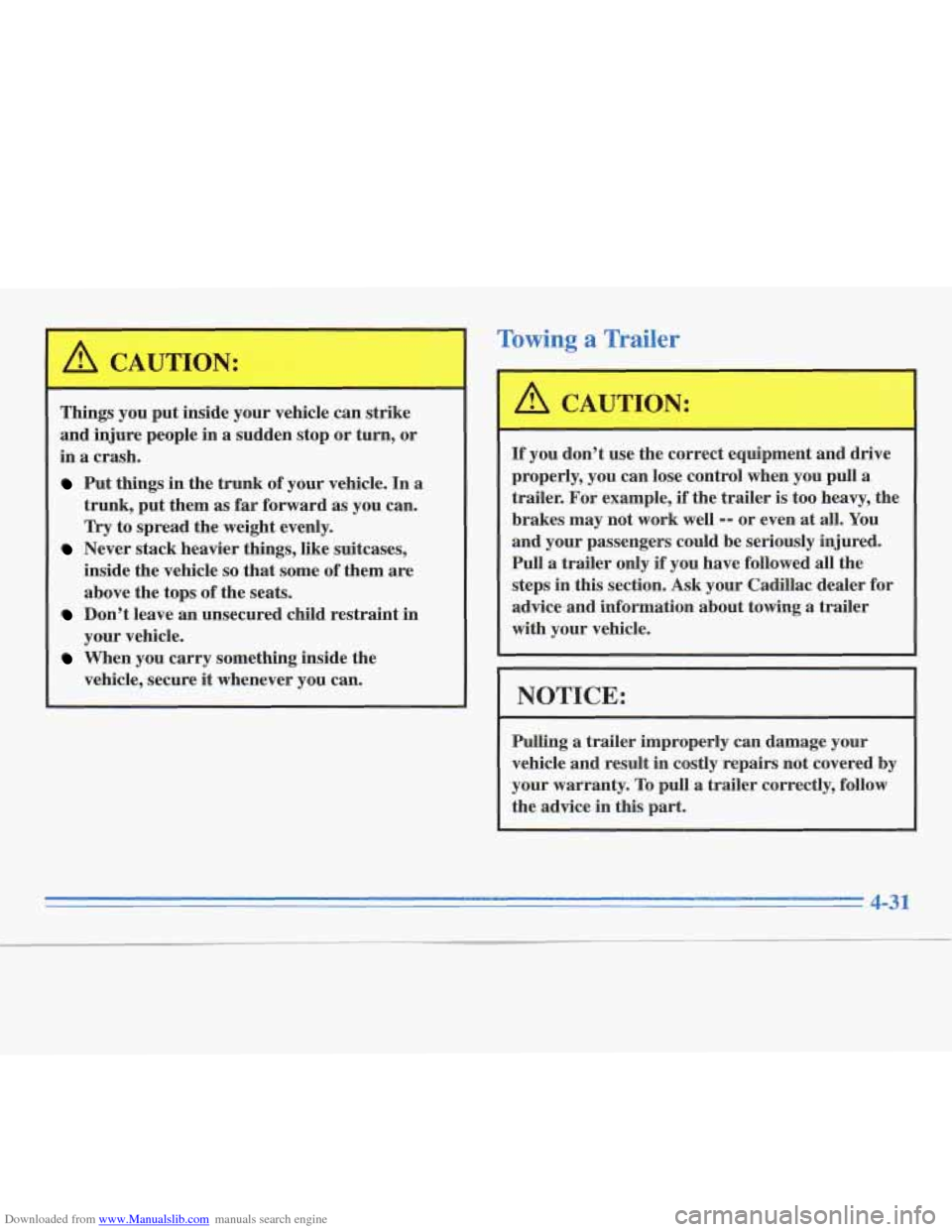
Downloaded from www.Manualslib.com manuals search engine Things you put inside your vehicle can strike
and injure people in a sudden stop or turn, or
in
a crash.
Put things in the trunk of your vehicle. In a
trunk, put them as far forward as you can.
Try to spread the weight evenly.
Never stack heavier things, like suitcases,
inside the vehicle
so that some of them are
above the tops of the seats.
Don’t leave an unsecured child restraint in
your vehicle.
When you carry something inside the
vehicle, secure
it whenever you can.
Towing a Trailer
CAUTION:
If you don’t use the correct equipment and drive
properly, you can lose control when you pull a
trailer. For example, if the trailer
is too heavy, the
brakes may not work well
-- or even at all. You
and your passengers could be seriously injured.
Pull
a trailer only if you have followed all the
steps in this section. Ask your Cadillac dealer for
advice and information about towing a trailer
with your vehicle.
1 NOTICE:
Pulling a trailer improperly can damage your
vehicle and result in costly repairs not covered by
your warranty.
To pull a trailer correctly, follow
the advice in this part.
Page 177 of 306

Downloaded from www.Manualslib.com manuals search engine Your vehicle can tow a trailer if it is equipped with
proper towing equipment. To identify what the vehicle
trailering capacity is for your vehicle, you should read
the information in “Weight of the Trailer” that appears
later in this section. But trailering is different than just
driving your vehicle by itself. Trailering means changes
in handling, durability, and fuel economy. Successful,
safe trailering takes correct equipment, and it has to be
used properly.
That’s the reason for this part. In it
are many
time-tested, important trailering tips and safety rules.
Many of these are important for your safety and that of
your passengers.
So please read this section carefully
before you pull a trailer.
Your Cadillac is a passenger vehicle. Trailer towing can
change the way your vehicle performs on the road. The
loads and forces created when trailering subject the
vehicle to significant levels of stress.
Load-pulling components such as the engine, transmission, rear axle, wheel assemblies and tires are
forced to work harder against the drag
of the added
weight. The engine is required to operate at relatively
higher speeds and under greater loads, generating extra
heat. What’s more, the trailer adds considerably to wind
resistance, increasing the pulling requirements.
If You Do Decide To Pull A Trailer
If you do, here are some important points:
0
0
e
0
0
There are many different laws, including speed limit
restrictions, having to do with trailering. Make sure
your rig will be legal, not only where you live but
also where you’ll be driving.
A good source for this
information can be state
or provincial police.
You should always use a weight distributing
(equalizing) hitch if your trailer will weigh more
than 3,000 lbs. (1 362 kg). Consider using sway
control if your loaded trailer will weigh 3,000 lbs.
(1 362 kg) or more. You can ask a hitch dealer
about sway controls.
Consider using a sway control if your trailer will
weigh 2,000 lbs.
(900 kg) or less. You should always
use a sway control if your trailer will weigh more
than
2,000 lbs. (900 kg). You can ask a hitch dealer
about sway controls.
Trailers that weigh more than
1,000 lbs. (454 kg)
should be equipped with trailer brakes.
Surge brakes may be used on some trailers (e.g., boat
trailers). However, surge brakes do not work well with most sway control devices.
Do not use sway
control devices on trailers equipped with surge brakes.
4-32
Page 178 of 306
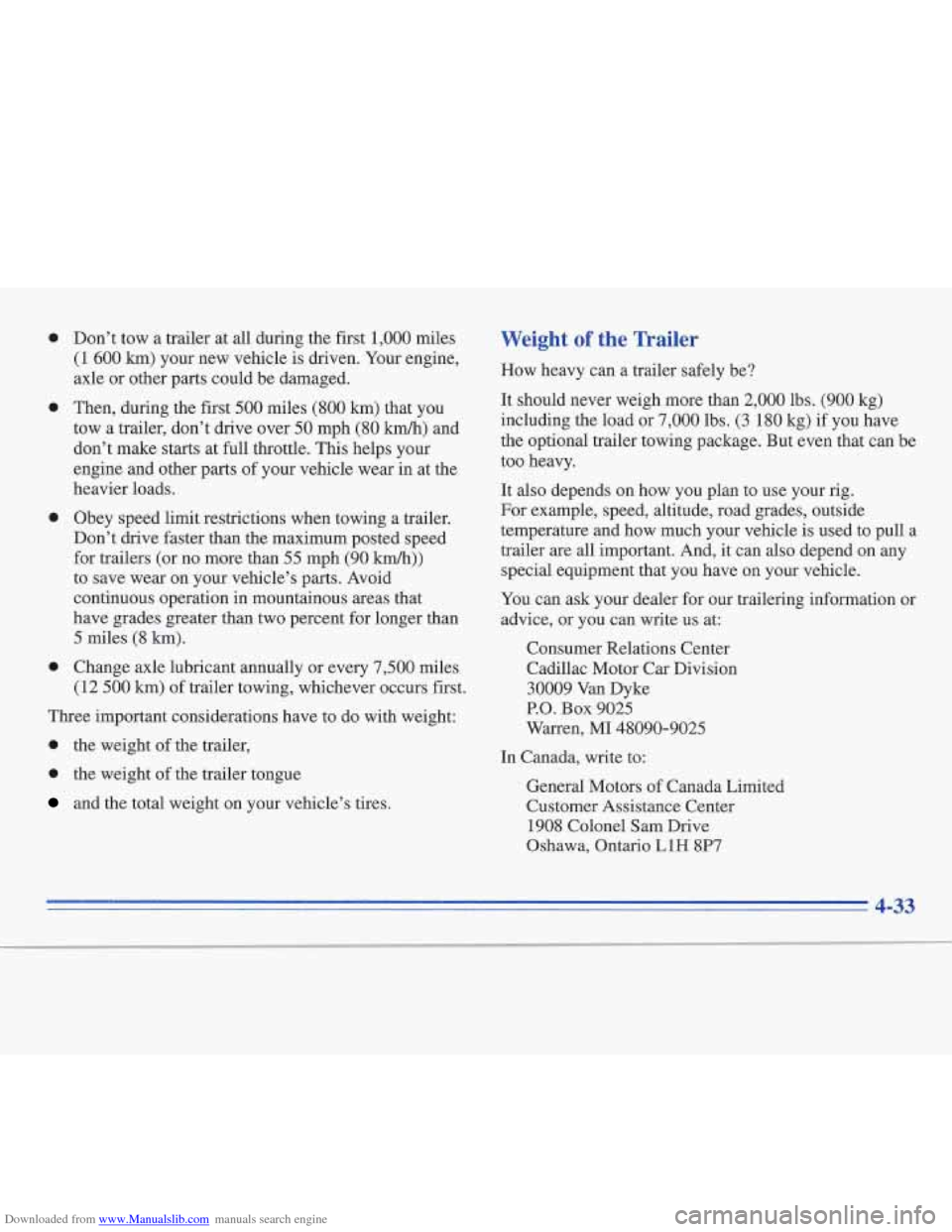
Downloaded from www.Manualslib.com manuals search engine 0
0
0
0
Don’t tow a trailer at all during the first 1,000 miles
(1
600 km) your new vehicle is driven. Your engine,
axle or other parts could be damaged.
Then, during the first
500 miles (800 km) that you
tow a trailer, don’t drive over
50 mph (80 km/h) and
don’t make starts at full throttle. This helps your
engine and other parts
of your vehicle wear in at the
heavier loads.
Obey speed limit restrictions when towing a trailer.
Don’t drive faster than the maximum posted speed
for trailers (or no more than
55 mph (90 km/h))
to save wear on your vehicle’s parts. Avoid
continuous operation in mountainous areas that
have grades greater than two percent for longer than
5 miles (8 km).
Change axle lubricant annually or every 7,500 miles
(12
500 km) of trailer towing, whichever occurs first.
Three important considerations have to do with weight:
0 the weight of the trailer,
0 the weight of the trailer tongue
and the total weight on your vehicle’s tires.
Weight of the Trailer
How heavy can a trailer safely be?
It should never weigh more than 2,000 lbs.
(900 kg)
including the load or 7,000 lbs. (3 180 kg) if you have
the optional trailer towing package. But even that can be
too heavy.
It also depends on how you plan to use your rig.
For example, speed, altitude, road grades, outside
temperature and how much your vehicle is used
to pull a
trailer are all important. And, it can also depend
on any
special equipment that
you have on your vehicle,
You can ask your dealer for our trailering information or
advice, or you can write us at:
Consumer Relations Center
Cadillac Motor Car Division
30009 Van Dyke
P.O. Box 9025
Warren, MI 48090-9025
In Canada, write to:
General Motors of Canada Limited
Customer Assistance Center 1908 Colonel Sam Drive
Oshawa, Ontario L1
H 8P7
4-33
Page 179 of 306

Downloaded from www.Manualslib.com manuals search engine Weight of the Trailer Tongue
The tongue load (A) of any trailer is an important
weight to measure because it affects the total capacity
weight of your vehicle.
The capacity weight includes the
curb weight of the vehicle, any cargo you may carry in
it, and the people who will be riding in the vehicle. And
if you will tow a trailer, you must subtract the tongue
load from your vehicle’s capacity weight because your
vehicle will be carrying that weight, too. See “Loading
Your Vehicle” in the Index for more information about
your vehicle’s maximum load capacity.
B A
If you’re using a weight-carrying hitch, the trailer
tongue
(A) should weigh 10% of the total loaded trailer
weight
(B). If you have a “weight-distributing” hitch,
the trailer tongue
(A) should weigh 12% of the total
loaded trailer weight
(B).
After you’ve loaded your trailer, weigh the trailer and
then the tongue, separately, to see if the weights
are
proper. If they aren’t, you may be able to get them right
simply by moving some items around in the trailer.
Total Weight on Your Vehicle’s Tires
Be sure your vehicle’s tires are inflated to the
recommended pressure for cold tires. You’ll find these numbers on the Certification label at the
rear edge of the
driver’s door or
see “Loading Your Vehicle” in the Index.
Then be sure you don’t go over
the GVW limit for your
vehicle, including the weight
of the trailer tongue.
The Gross Combined Vehicle Weight (GCVW)
= curb
weight
+ passengers’ weight + cargo + trailer weight.
It should never exceed 7,450 lbs.
(3 1 SO kg) for the
standard vehicle
or 12,100 lbs. (5 490 kg) for the
7,000 lb. towing package.
4-34
Page 180 of 306
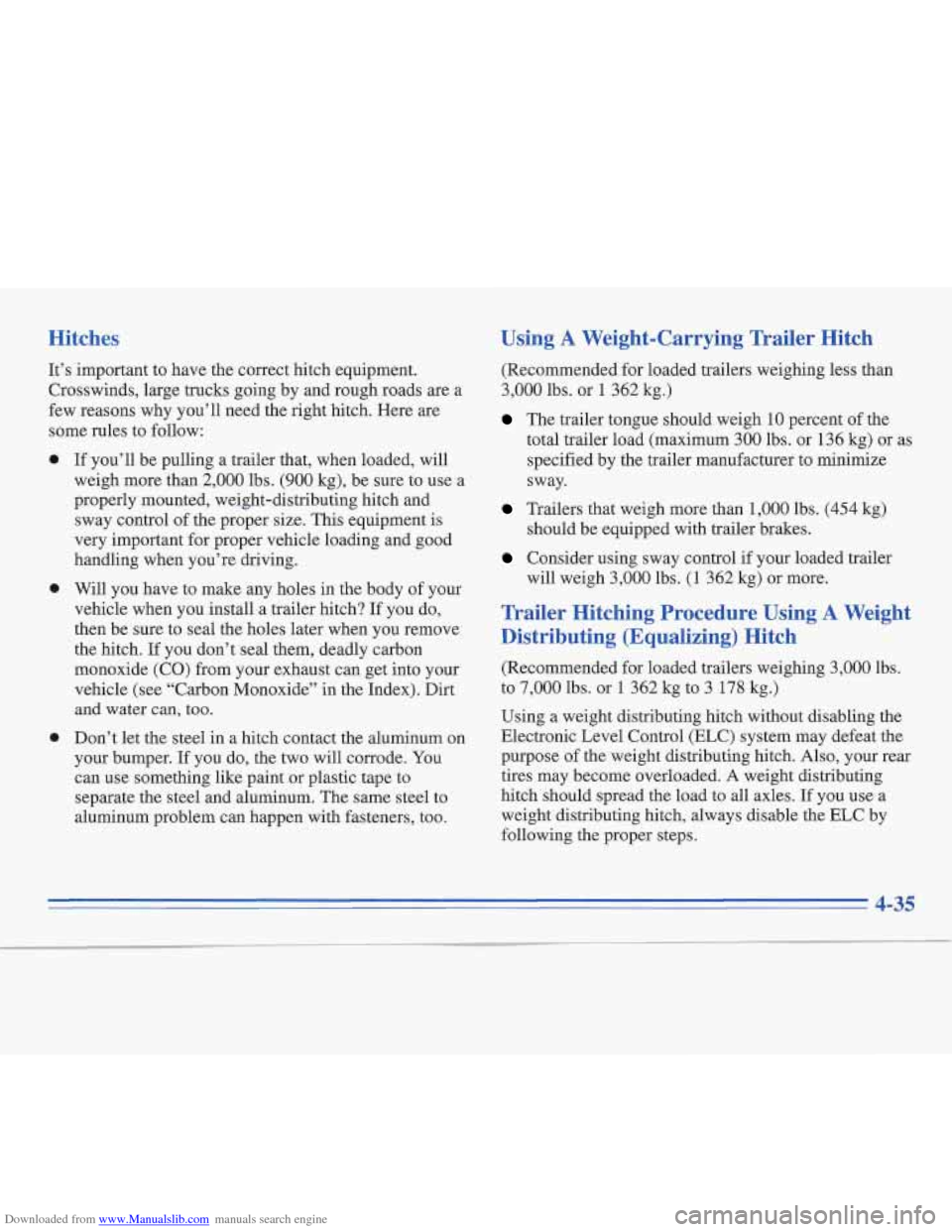
Downloaded from www.Manualslib.com manuals search engine Hitches
It’s important to have the correct hitch equipment.
Crosswinds, large trucks going by and rough roads are a
few reasons why you’ll need the right hitch. Here
are
some rules to follow:
e
e
e
If you’ll be pulling a trailer that, when loaded, will
weigh more than 2,000 lbs.
(900 kg), be sure to use a
properly mounted, weight-distributing hitch and
sway control of the proper size. This equipment
is
very important for proper vehicle loading and good
handling when you’re dnving.
Will you have to make any holes in the body of your
vehicle when you install a trailer hitch? If you do,
then be sure to seal the holes later when you remove
the hitch. If you don’t seal them, deadly carbon
monoxide (CO) from your exhaust can get into your
vehicle (see “Carbon Monoxide” in the Index). Dirt
and water can, too.
Don’t
let the steel in a hitch contact the aluminum on
your bumper. If you do, the two will corrode. You
can use something like paint or plastic tape to
separate the steel and aluminum. The same steel to
aluminum problem can happen with fasteners, too.
Using A Weight-Carrying Trailer Hitch
(Recommended for loaded trailers weighing less than
3,000 lbs. or
1 362 kg.)
The trailer tongue should weigh 10 percent of the
total trailer load (maximum 300 lbs. or 136 kg) or as
specified by the trailer manufacturer to minimize
sway.
Trailers that weigh more than 1,000 lbs. (454 kg)
should be equipped with trailer brakes.
Consider using sway control if your loaded trailer
will weigh 3,000 lbs.
(1 362 kg) or more.
Trailer Hitching Procedure Using A Weight
Distributing (Equalizing) Hitch
(Recommended for loaded trailers weighing 3,000 lbs.
to
7,000 lbs. or 1 362 kg to 3 178 kg.)
Using a weight distributing hitch without disabling the
Electronic Level Control (ELC) system may defeat the
purpose
of the weight distributing hitch. Also, your rear
tires may become overloaded. A weight distributing
hitch should spread the load to all axles. If you use a
weight distributing hitch, always disable the ELC by
following the proper steps.
4-35